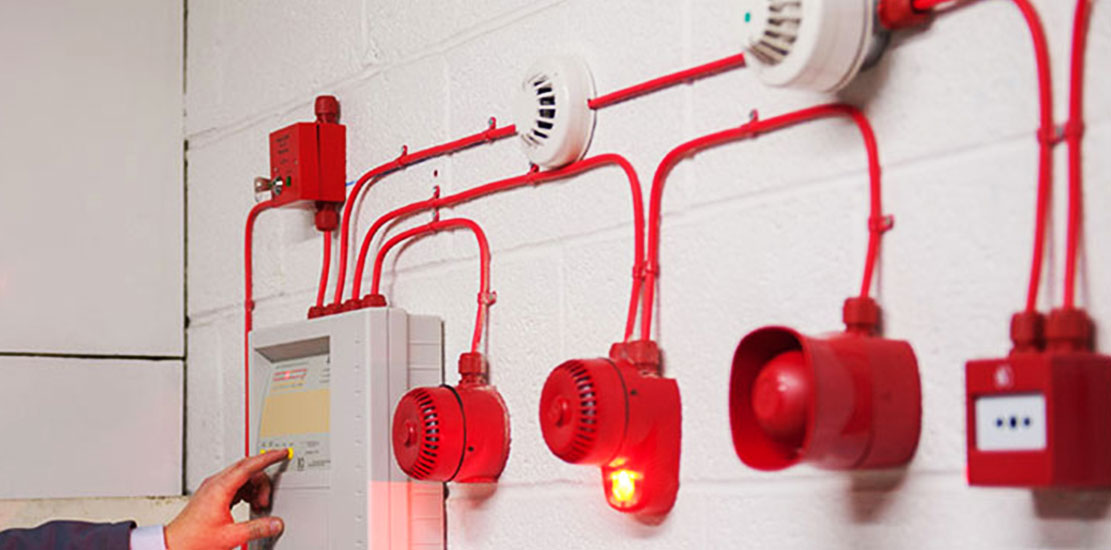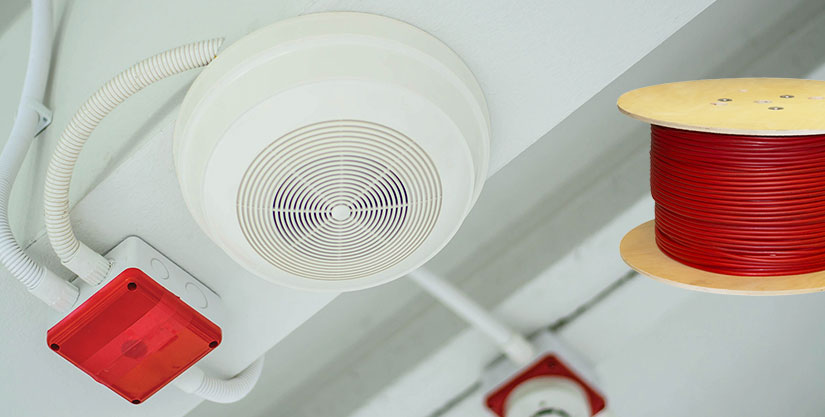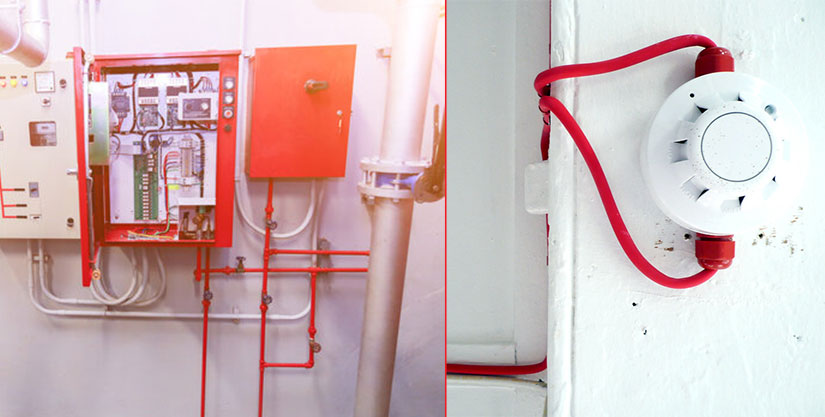
Fire Alarm Cables: The Most Overlooked Yet Critical Part of Building's Safety System
Fire alarm cables are an integral part of the fire alarm system used in buildings, hospitals, industrial units, and other commercial and residential units. These cables connect to smoke detectors, emergency lighting, and other safety systems to help avoid any mishappening.
However, fire alarm cables usually get unnoticed due to a lack of knowledge about their functionality and significance to the building’s security system. These cables designed for fire alarm systems adhere to all safety and compliance standards.
Gloster Cables manufactures a range of fire alarm cables for different fire alarm systems.
What are Fire Alarm Cables and How They Differ from Regular Cables
The fire alarm cable is the backbone of a fire-alarm system with a core function to transmit signals from one place to another in a fire emergency. These cables are the critical component of a fire alarm circuit that regulates and powers several lifesaving applications, safety functions, doorway release, and inhibition.
A fire alarm cable demands higher fire resistivity and is different from regular cables. An ordinary PVC insulated cable exposed to fire burns easily, interfering with the integrity of the fire alarm system. These fire alarm cables are usually made from thermoplastic materials and copper, making them resistant to flame and heat. They have two or more conductors with several insulated wires and resistance welded together in a single unit to withstand heat and fire for the fire alarm system protection.
The Type of Cables Required for Fire Alarm

The fire alarm system has got primarily divided into conventional (analog), addressable (digital), and multiplex systems (analog & digital). The Conventional fire alarm system in use for many years has changed a bit in terms of technology. It is a well-proven technology protecting properties across the world.
Conventional fire alarm cables consider AWG of the cable for its design. Further, the two categories of conventional fire-alarm cables are power-limited fire-alarm cables and non-power-limited fire-alarm cables.
Power Limited Fire Alarm (PLFA) Cables
Power-limited fire alarm cables function within the 24-volt DC range. PLFA circuits are inherently unable to exceed maximum voltage equipped with a power-limiting source like a transformer or battery and a circuit breaker. Different types of PLFA cables in use are
 FPL Cable
FPL Cable
The National Electric Code (NEC) has recognized Fire power limited (FPL) cables as suitable for general-purpose fire alarm use. The listing excludes installation in ducts, risers, and other spaces used for environmental air unless the cable gets installed in the conduit. All FPL cables are listed as resistant to fire and must pass UL 1424 test and vertical flame test. i.e., UL 1581.
 FPLR Cable
FPLR Cable
Firepower limited riser (FPLR) cables are adequate fire-resistant and have low-smoking characteristics. FPLR cables designed to meet specific fire safety standards use a special coating during construction that helps prevent the spreading of flames. These cables must pass UL test 1424 and vertical riser test UL 1666.
FPLR cables are in use in commercial or institutional settings where there is the restriction of installation of standard data cables due to fire possibility. NEC has listed these cables as suitable for ducts, plenums, and other spaces used for environmental air. FPLR cables are fit for use in a vertical run through a shaft or from floor to floor within a building.
 FPLR Shielded Cable
FPLR Shielded Cable
FPLR shielded cables are specifically designed for fire alarm systems and are available in various configurations like twisted pair, coaxial and multi-color.
This cable design includes two insulated copper conductors and a layer of aluminum foil shielding, protecting the signal from electromagnetic interference (EMI) and radio frequency interference (RFI). The PVC jacketing helps protect the conductor from damage.
FPLR-shielded cables are preferable for areas with high EMI or RFI, such as data centers, computer rooms, telecommunication installations, etc.
 FPLP Cable
FPLP Cable
The Fire alarm power limited plenum (FPLP) cables are specific designed cables to meet the requirements of a plenum space. The space in a building used for ventilation and air circulation, like the attic, crawlspace, or raised floor, is known as plenum space. These spaces are for heating, cooling, and electrical wiring and potentially can pose a serious hazard.
Treatment of these cables with special coating helps suppress the spread of fire. They also have a low power rating, suitable for low-voltage devices like smoke detectors and alarms.
 FPLP Shielded Cable
FPLP Shielded Cable
FPLP shielded cables are power-limited plenum fire alarm cables with an aluminum polyester foil shield and drain wire that blocks any additional interference within the cable. Its foil insulation surrounding the conductor prevents unwanted signals from penetrating the cable and protects against EMI and RFI. These features make the cable suitable for factories and industrial settings, where there is a lot of noise and electromagnetic interference.
Non-Power Limited Fire Alarm Cables

Non-power limited fire alarm cables are fire alarm circuits powered by a source complying with NEC sections 760-21 and 760-23. These cables can operate at a maximum of 600 volts. These cables are NPLF and NPLFP cables.
 NPLF Cables
NPLF Cables
NPLF fire alarm cables can transmit fire alarms even when there is no power running to the system, and fire alarm works even when there is a power outage using NPLF cables. These flame-retardant cables must pass UL test 1424 and the vertical flame test UL 1581.
 NPLFP Cables
NPLFP Cables
NPLFP cables have adequate fire resistance and low-smoke-producing characteristics. It limits the spread of fire by restricting the flow of combustible gases and flames, providing valuable time for emergency responders. These cables have a fire-protective shield that limits the heat amount passing from the protected conductor to the combustible materials.
Basic Design and Standard of Conventional Fire Alarm Cables
The design and reliability of conventional fire alarm cables have improved significantly. The AWG size of these cables is significant as it defines the electrical property of conventional cables. A conventional fire alarm cable includes
Conductor
A Conventional fire alarm cable has a copper conductor, and the size of the conductor should not be less than 26 AWG. These cables also include a solid or stranded conductor, and in the case of a single conductor, the size is smaller than 16 AWG.
Insulation
FPLR fire alarm cables get insulated with PVC or polypropylene, and FPLP fire alarm cables are PVC insulated for plenum rated. The conductors are either cables or twisted in pairs.
Shielding
We can use shielded or unshielded fire alarm cables based on environmental conditions and alarm system requirements. These shields are usually 100 percent aluminium foil wrap. The shielded fire alarm cables combat noisy EMI and are used while installing exceptionally long cable runs.
Jacketing
PVC as a jacketing material for non-plenum FPLR cables. And flexible fire-retardant PVC for FPLP cables. The colour of jackets can be red or any other colour.
Fire alarm cable design must meet the comprehensive British Standard- BS58391. The British Standard BS583891-1 details the code practice for the design, commissioning, installation, and maintenance of fire detection and fire alarm system in non-domestic buildings. It also covers the operation of fire protection systems, such as smoke control, emergency lighting, etc.
Selection of a Right Fire Alarm Cable Ensures Building’s Safety

The selection of appropriate fire alarm type cable is crucial to ensure the safety of the building and its occupants. Gloster Cables is a wire and cable manufacturing house offering a wide variety of fire alarm cables to choose, from and meet your alarm system and environmental conditions requirements. Gloster follows a stringent design standard adherence and test policy for its FPLR, FPLP, and shielded fire alarm cables to ensure maximum safety.
CONTACT US